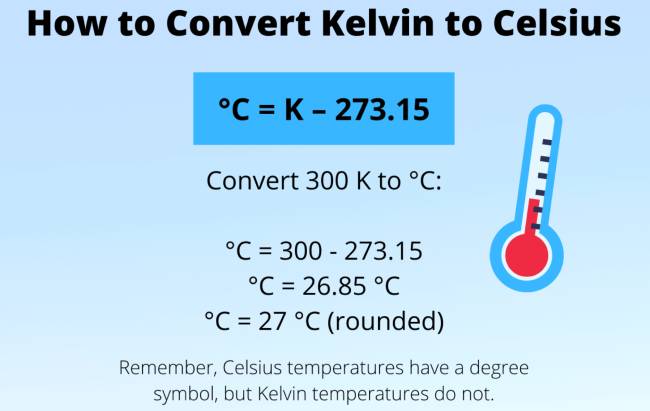There are two temperature scales: Kelvin and Celsius. In both scales, the “degree” is of the same magnitude, but the Kelvin scale begins at absolute zero (the lowest theoretical temperature attainable), whereas the Celsius scale starts at 32.01 F, the triple point of water (the point at which water exists in solid, liquid, and gaseous states).
It only takes a few basic math skills to convert Kelvins and Celsiuss.

Table of Contents
Key Takeaways: Kelvin to Celsius Temperature Conversion
- In order to convert Kelvin to Celsius, use the equation C = K – 273.15.
- Despite the fact that Kelvin and Celsius degrees have the same size, a Celsius temperature will always be higher than a Kelvin temperature.
- Negative temperatures are possible for Celsius; negative temperatures are not possible for Kelvin.
Conversion Formula
Kelvin is converted into Celsius by the formula C = K – 273.15. The process is simple:
You will need to subtract 273.15 from your Kelvin temperature to get your answer. Celsius is the unit of measurement for your answer. K does not use the word degree or the symbol; depending on the context, either one (or simply C) is used.
Kelvin to Celsius
500 K is equal to how many degrees Celsius?
The value of C is 500 – 273.15
The temperature of 500 K is 226.85 degrees Celsius
To convert Kelvin to Celsius, let’s convert normal body temperature. The average human body temperature is 310.15 K. Solve for degrees Celsius using the following equation:
The value of C is K – 273.15
The value of C is 310.15 minus 273.15
The temperature of the human body is 37 degrees Celsius
Reverse Conversion: Celsius to Kelvin
The Kelvin scale can be easily converted from Celsius to Kelvin. If you don’t want to use the formula above, you can use K = C + 273.15.
Consider converting the boiling point of water to Kelvin. Water has a boiling point of 100 degrees Celsius. Fill in the formula with the value:
The value of K is 100 plus 273.15
The value of K is 373.15
About Absolute Zero
Temperatures experienced in everyday life are typically expressed in Celsius or Fahrenheit, but many phenomena can be better described using an absolute temperature scale. Kelvin’s scale is based on energy measurement (the movement of molecules) and begins at absolute zero (the coldest temperature attainable). Science uses the Kelvin scale for measuring temperature in many fields, including astronomy and physics.
It’s perfectly normal to get negative Kelvin values, but not for Celsius. Absolute zero is also known as zero K. Since there is no molecular movement at absolute zero, there can be no further heat removal.
This means that the lowest possible Celsius temperature you can ever achieve is minus 273.15 C. You should check your calculations if you ever achieve a temperature lower than that.
